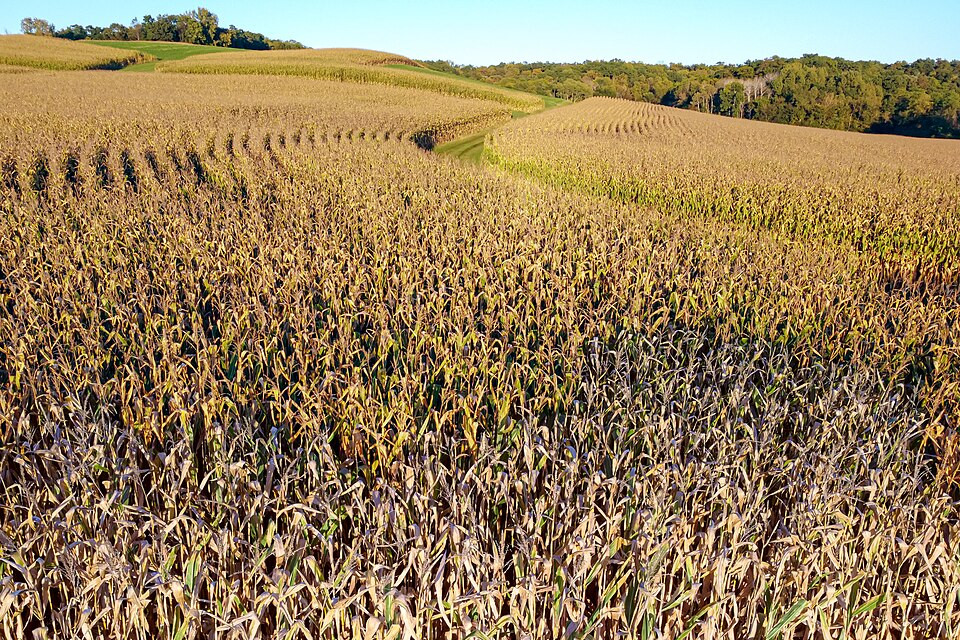UDiscoverIt Downloads — Agriculture, Soils, and Food Systems

A corn field in Wisconsin, USA. Crop yields are highly sensitive to extreme weather conditions such as heatwaves and droughts. Soil quality plays a major role as well.
While the world population is projected to increase to 10 billion by 2050, our food systems are struggling to keep up. Feeding our rapidly-growing population in a sustainable way presents a major challenge, as food production is highly sensitive to extreme weather and contributes to environmental degradation. In order for policymakers to make informed decisions about this, accurate predictions are crucial. Forecasting crop yields and monitoring crop health helps policymakers and farmers prevent food insecurity and stabilize supply chains. Aquaculture (fish farming) can provide another sustainable source of protein, but may result in deforestation and land degradation; we need accurate maps of aquaculture expansion to help policymakers navigate these tradeoffs. Soils also have the potential to sequester carbon dioxide and mitigate climate change, but we need clear information on how long carbon stays in the soil in different environments. While these problems have proven challenging for traditional AI methods due to limited or biased data, we are developing state-of-the-art AI methods that leverage spatiotemporal structure, scientific knowledge, and weak supervision to tackle these challenges, giving us better predictions and scientific insights.
Accurately forecasting crop yields helps policymakers and farmers make decisions to prevent food insecurity and stabilize supply chains. However, this prediction task is exceptionally complicated since crop yields depend on numerous factors such as weather, land surface, and soil quality, as well as their interactions. While simple machine learning models have begun to be adopted in this domain, they struggle with the high dimensionality and complex spatiotemporal structure of the data. Our team has proposed a GNN-RNN framework for the complex spatiotemporal prediction task of forecasting crop yields. Our model adapts graph, recurrent, and convolutional neural networks into a state-of-the-art deep architecture that captures the spatial and temporal structure of our dataset. We provide Python code that implements the GNN-RNN model in PyTorch and trains it to predict corn and soybean yields for US counties. We also release a comprehensive dataset of county-level yield, weather, soil moisture, and soil texture data for over 3000 counties in the US, ranging from 1981–2020.
Files
Related Publications
- Joshua Fan, Junwen Bai, Zhiyun Li, Ariel Ortiz-Bobea, Carla P. Gomes. A GNN-RNN Approach for Harnessing Geospatial and Temporal Information: Application to Crop Yield Prediction. AAAI 2022: 11873-11881 [pdf]
- Joshua Fan, Junwen Bai, Zhiyun Li, Ariel Ortiz-Bobea, Carla P. Gomes. A GNN-RNN Approach for Harnessing Geospatial and Temporal Information: Application to Crop Yield Prediction. CoRR abs/2111.08900 (2021) [pdf]
2025
- Laura Greenstreet, Qinru Shi, Marc Grimson, Franz W. Simon, Suresh Andrew Sethi, Carla P. Gomes, Andrea Lodi, David B. Shmoys. Reducing Income Variability in Natural Resource Portfolios via Integer Programming. CPAIOR (2) 2025: 18-34 [pdf]
- Haodi Xu, Joshua Fan, Feng Tao, Lifen Jiang, Fengqi You, Benjamin Z. Houlton, Ying Sun, Carla P. Gomes, Yiqi Luo. Biogeochemistry-Informed Neural Network (BINN) for Improving Accuracy of Model Prediction and Scientific Understanding of Soil Organic Carbon. CoRR abs/2502.00672 (2025) [pdf]
- Joshua Fan, Haodi Xu, Feng Tao, Md Nasim, Marc Grimson, Yiqi Luo, Carla P. Gomes. Scientifically-Interpretable Reasoning Network (ScIReN): Uncovering the Black-Box of Nature. CoRR abs/2506.14054 (2025) [pdf]
- Sebastian A. Heilpern, Franz W. Simon, Suresh A. Sethi, Kathryn J. Fiorella, Alexander S. Flecker, Carla Gomes, Peter B. McIntyre. Leveraging biodiversity to maximize nutrition and resilience of global fisheries. Nature Sustainability (2025). [pdf]
- Felipe S. Pacheco, Sebastian A. Heilpern, Claire DiLeo, Rafael M. Almeida, Suresh A. Sethi, Marcela Miranda, Nicholas Ray, Nathan O. Barros, Jucilene Cavali, Carolina Costa, Carolina R. Doria, Joshua Fan, Kathryn J. Fiorella, Bruce R. Forsberg, Marcelo Gomes, Laura Greenstreet, Meredith Holgerson, David McGrath, Peter B. McIntyre, Patricia Moraes-Valenti, Ilce Oliveira, Jean P. H. B. Ometto, Fabio Roland, Adry Trindade, Marta E. Ummus, Wagner C. Valenti, Xiangtao Xu, Carla P. Gomes, Alexander S. Flecker. Towards sustainable aquaculture in the Amazon. Nature Sustainability (2025). [pdf]
2024
- Brendan Hogan, Anmol Kabra, Felipe Siqueira Pacheco, Laura Greenstreet, Joshua Fan, Aaron M. Ferber, Marta Ummus, Alecsander Brito, Olivia J. Graham, Lillian R. Aoki, Drew Harvell, Alex Flecker, Carla P. Gomes. AiSciVision: A Framework for Specializing Large Multimodal Models in Scientific Image Classification. CoRR abs/2410.21480 (2024) [pdf]
2023
- Laura Greenstreet, Joshua Fan, Felipe Siqueira Pacheco, Yiwei Bai, Marta Eichemberger Ummus, Carolina Doria, Nathan Oliveira Barros, Bruce R Forsberg, Xiangtao Xu, Alexander Flecker, Carla P Gomes. Detecting Aquaculture with Deep Learning in a Low-Data Setting. KDD 2023 Fragile Earth Workshop (2023). [pdf]
2022
- Joshua Fan, Junwen Bai, Zhiyun Li, Ariel Ortiz-Bobea, Carla P. Gomes. A GNN-RNN Approach for Harnessing Geospatial and Temporal Information: Application to Crop Yield Prediction. AAAI 2022: 11873-11881 [pdf]
- Joshua Fan, Di Chen, Jiaming Wen, Ying Sun, Carla P. Gomes. Monitoring Vegetation From Space at Extremely Fine Resolutions via Coarsely-Supervised Smooth U-Net. IJCAI 2022: 5066-5072 [pdf]
- Joshua Fan, Di Chen, Jiaming Wen, Ying Sun, Carla P. Gomes. Monitoring Vegetation From Space at Extremely Fine Resolutions via Coarsely-Supervised Smooth U-Net. CoRR abs/2207.08022 (2022) [pdf]
2021
- Joshua Fan, Junwen Bai, Zhiyun Li, Ariel Ortiz-Bobea, Carla P. Gomes. A GNN-RNN Approach for Harnessing Geospatial and Temporal Information: Application to Crop Yield Prediction. CoRR abs/2111.08900 (2021) [pdf]
- Joshua Fan, Junwen Bai, Zhiyun Li, Ariel Ortiz-Bobea, Carla P Gomes. A GNN-RNN Approach for Harnessing Geospatial and Temporal Information: Application to Crop Yield Prediction. NeurIPS 2021 Workshop on Tackling Climate Change with Machine Learning (2021). [pdf]
- Joshua Fan, Di Chen, Jiaming Wen, Ying Sun, Carla P Gomes. Resolving Super Fine-Resolution SIF via Coarsely-Supervised U-Net Regression. NeurIPS 2021 Workshop on Tackling Climate Change with Machine Learning (2021). [pdf]